Transmission interrupted: signal lost

Forms of perceptual learning

“The systems approach begins when first you see the world through the eyes of another” wrote C. West Churchman. Seeing things from another’s point of view is usually framed as ‘empathy’ but often what isn’t discussed is the effect that a change in perspective can have on a person themselves. This is sometimes colloquially and humorously referred to as “things we cannot unsee”. It’s automatic: the way we understand the world has changed.
Stephen Downes shared this recently-updated article from the Stanford Encyclopedia of Philosophy about a topic which I’ve only studied obliquiely. ‘Perceptual learning’ is about long-lasting changes in perception resulting from practice or experience, and can take four forms: differentiation, unitization, attentional weighting, and stimulus imprinting.
When most people reflect on perceptual learning, the cases that tend to come to mind are cases of differentiation. In differentiation, a person comes to perceive the difference between two properties, where they could not perceive this difference before. It is helpful to think of William James’ case of a person learning to distinguish between the upper and lower half of a particular kind of wine. Prior to learning, one cannot perceive the difference between the upper and lower half. However, through practice one becomes able to distinguish between the upper and lower half. This is a paradigm case of differentiation.
[…]
Unitization is the counterpart to differentiation. In unitization, a person comes to perceive as a single property, what they previously perceived as two or more distinct properties. One example of unitization is the perception of written words. When we perceive a written word in English, we do not simply perceive two or more distinct letters. Rather, we perceive those letters as a single word. Put another way, we perceive written words as a single unit (see Smith & Haviland 1972). This is not the case with non-words. When we perceive short strings of letters that are not words, we do not perceive them as a single unit.
[…]
In attentional weighting, through practice or experience people come to systematically attend toward certain objects and properties and away from other objects and properties. Paradigm cases of attentional weighting have been shown in sports studies, where it has been found, for instance, that expert fencers attend more to their opponents’ upper trunk area, while non-experts attend more to their opponents’ upper leg area (Hagemann et al., 2010). Practice or experience modulates attention as fencers learn, shifting it towards certain areas and away from other areas.
[…]
Recall that in unitization, what previously looked like two or more objects, properties, or events later looks like a single object, property, or event. Cases of “stimulus imprinting” are like cases of unitization in the end state (you detect a whole pattern), but there is no need for the prior state—no need for that pattern to have previously looked like two or more objects, properties, or events. This is because in stimulus imprinting, the perceptual system builds specialized detectors for whole stimuli or parts of stimuli to which a subject has been repeatedly exposed (Goldstone 1998: 591). Cells in the inferior temporal cortex, for instance, can have a heightened response to particular familiar faces (Perrett et al., 1984, cited in Goldstone 1998: 594).
Source: Stanford Encyclopedia of Philosophy
Image: CHUTTERSNAP
Llama 3 is only free to use until monthly active users exceed 700m

Amidst the drama around the WordPress project at the moment (which is, in my experience only a public version of what goes on behind the scenes of any major Open Source project) I was interested in a post by Matt Mullenweg.
I’ve been using Llama 3 on projects where it wouldn’t be appropriate to use OpenAI’s offerings, but I should have known that, given it’s from Meta, there would be some shenanigans. And so it proves.
I’ll not share the rest of the post, given Matt’s ‘ecosystem thinking’ seems a bit disingenuous given the spat he’s engaged in, but this bit shocked me.
Open Source, once ridiculed and attacked by the professional classes, has taken over as an intellectual and moral movement. Its followers are legion within every major tech company. Yet, even now, false prophets like Meta are trying to co-opt it. Llama, its “open source” AI model, is free to use—at least until “monthly active users of the products or services made available by or for Licensee, or Licensee’s affiliates, is greater than 700 million monthly active users in the preceding calendar month.” Seriously.
Excuse me? Is that registered users? Visitors to WordPress-powered sites? (Which number in the billions.) That’s like if the US Government said you had freedom of speech until you made over 50 grand in the preceding calendar year, at which point your First Amendment rights were revoked. No! That’s not Open Source. That’s not freedom.
I believe Meta should have the right to set their terms—they’re smart business, and an amazing deal for users of Llama—but don’t pretend Llama is Open Source when it doesn’t actually increase humanity’s freedom. It’s a proprietary license, issued at Meta’s discretion and whim. If you use it, you’re effectively a vassal state of Meta.
When corporations disingenuously claim to be “open source” for marketing purposes, it’s a clear sign that Open Source is winning.
Source: Ma.tt
Image: Managing Data Hazards by Yasmin Dwiputri & Data Hazards Project
The work to do the work
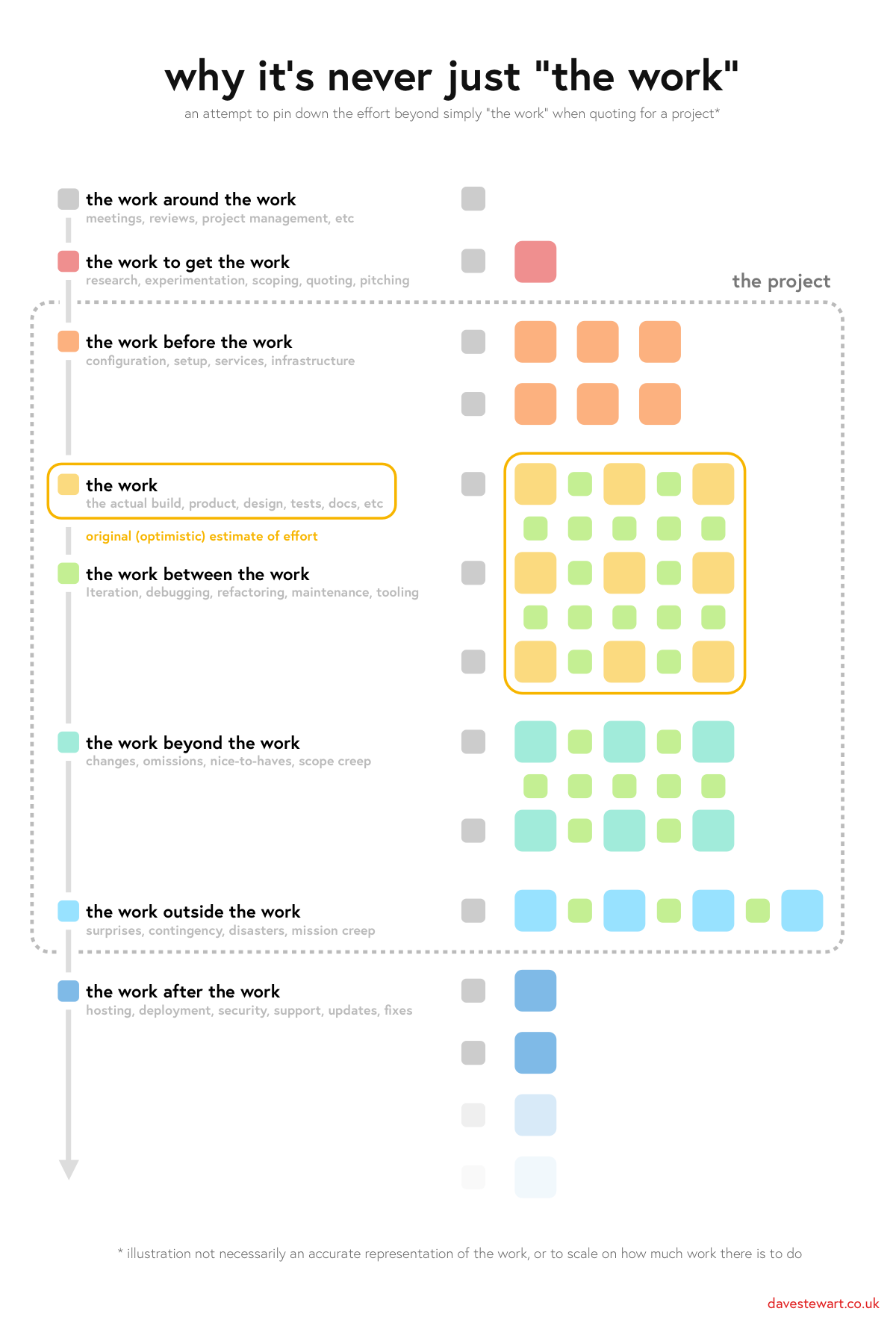
Abi Handley shared the above image on LinkedIn from a web developer who, back in 2022, worked out all of the time they spent on a project. Unsurprisingly, as anyone who has ever led a project will know, it’s the “work to do the work” which takes the most time.
When you’re younger, enthusiasm, energy and naivety tend to get you to the end of a project. When you’re in your forties, like me, it’s process. This post talks about running a ‘postmortem’ but we insist on pre-mortems as well as retrospectives. We minimise ‘status update’ meetings, using tools such as Trello to track task completion and Loom to explain things that would take too long via email.
Additionally, some people seem to think that being ‘professional’ means not bringing your emotions to work. But emotion is what makes us human, and so acknowledging this and factoring it into to projects is one of the keys to running them successfully.
I had been aware during the project that there seemed to be a lot of “extra work”, but putting it down on paper highlighted the multitude of “invisible” tasks and challenges which every web development project has.
There were two common threads:
- much of the work was the “work to do the work” rather than the “actual” work
- most of the work was under- or un-estimated because it wasn’t the “actual” work
Source: Dave Stewart
About time to head south for winter
I don’t think this is a new ‘False Knees’ cartoon, but it’s a great one and gave me a chuckle, especially at this time of the year. My SAD light is out, and it’s chilly in Northumberland.
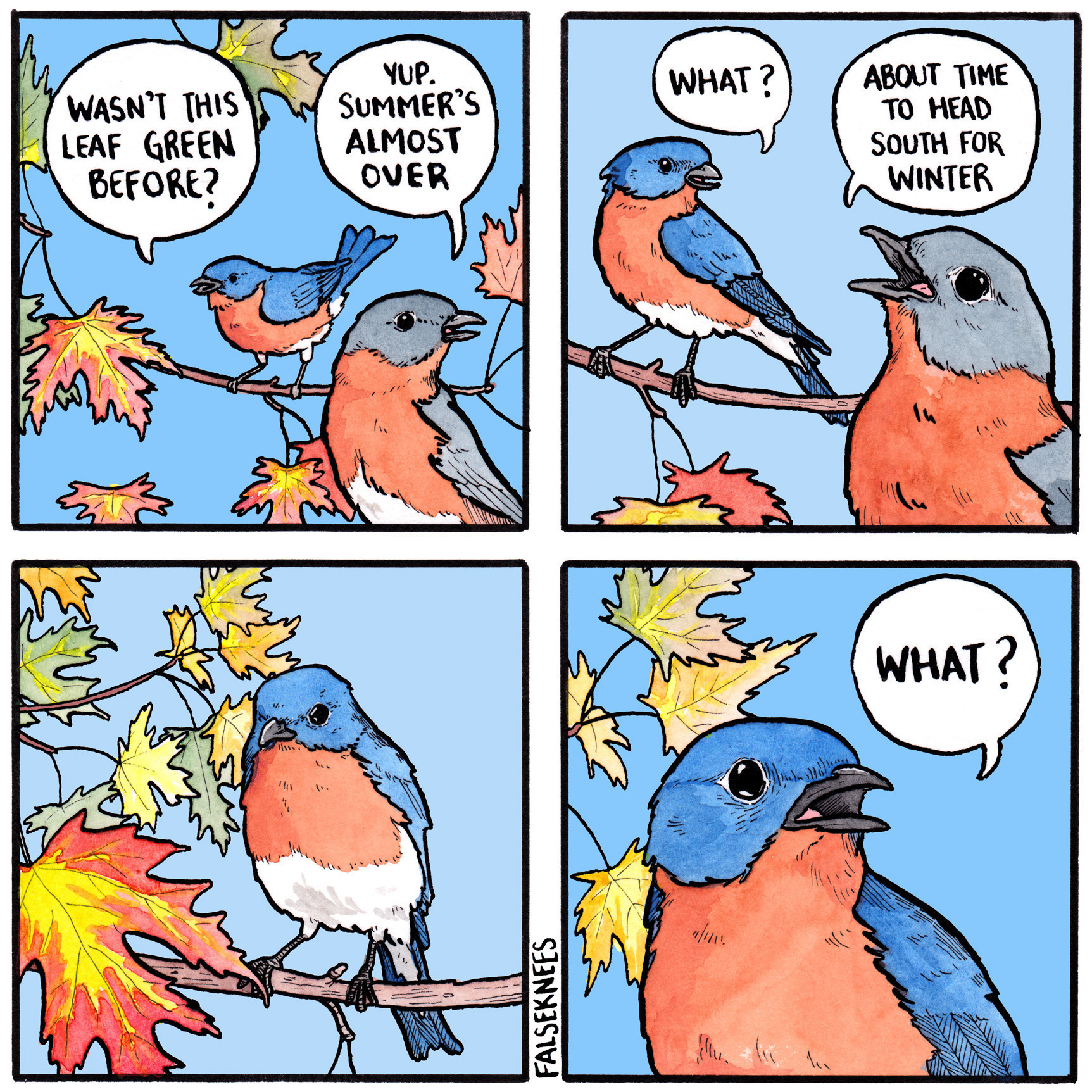
Source: False Knees
Ocean acidification approaches the boundary

I feel like this should perhaps be bigger news?
Boundaries that have already been exceeded have to do with climate change, freshwater availability, biodiversity, land use, nutrient pollution (such as phosphorus and nitrogen) and the introduction of synthetic chemicals and plastics to the environment.
Ocean acidification is one of the systems that has not yet crossed its planetary boundary, along with ozone depletion and aerosols in the atmosphere. But while ocean acidification is still in the “green zone,” the new report finds it’s trending in the wrong direction. Scientists now say this metric is on the brink and may cross out of the safe zone in the next few years.
Earth’s oceans absorb carbon dioxide from the atmosphere, providing a valuable carbon sink as humans burn fossil fuels. But this process also makes the oceans more acidic, which can disturb the formation of shells and coral skeletons and affect fish life cycles, per the report.
As ocean acidification approaches the boundary, scientists are particularly concerned about certain regions, like the Arctic and Southern oceans. These areas are vital for carbon and global nutrient cycles, “which support marine productivity, biodiversity and global fisheries,” the report says.
Source: Smithsonian Magazine
A Troll's Charter

Given the groups who financed Elon Musk’s acquisition of Twitter, I don’t think it’s unreasonable to see the events relating to the platform over the past few years as an attempt to stifle progressive discourse.
It’s been seven years since I deleted 77.5k tweets I composed between 2007 and 2017. I could see the way the wind was blowing, even before Musk’s acquisition. The latest news is that blocked users will still be able to see the tweets of the person who’s blocked them, which is just a troll’s charter.
If, for some reason, you’re still on there, perhaps it’s time to leave?
X will now make your posts visible to users you’ve blocked. In a reply on Monday, X owner Elon Musk said the “block function will block that account from engaging with, but not block seeing, public post.”
[…]
Musk has been vocal about his dislike of the block button. Last year, he said the feature “makes no sense” and that “it needs to be deprecated in favor of a stronger form of mute.” He also threatened to stop letting users block people on the platform completely, except for direct messages.
Source: The Verge
Image: BoliviaInteligente
A countercultural perspective to the capitalist notion of 'productivity'

This article examines how religious communities, particularly nuns and monks, approach productivity differently from the modern, output-driven culture. It highlights how members of religious orders redefine productivity as rooted in spiritual fulfilment, sufficiency, and human connection rather than constant work and economic gain.
These experiences suggest that true productivity lies in fruitfulness and grace, not in relentless efficiency, which offers somewhat of a countercultural perspective to the capitalist emphasis on always doing more.
We are conditioned to listen to podcasts while washing up, read books on the commute and dash out emails while drinking a morning coffee. I can’t even ‘just’ watch a Netflix show without needing something else to do, so resort to doing cross stitch in front of the TV in order to put my phone down. This is the efficiency for which we congratulate ourselves, getting more done in the same time. I draw the line at the growing trend for listening to podcasts at double speed to inhale the same information more efficiently, less fruitfully.
When I first raised the idea of writing this piece, and put out the rather niche call for nuns, priests and monks willing to be interviewed about productivity culture, I was struck by the number of responses from people desperate to read it. The desire for wisdom about life and work that isn’t geared just towards increasing the latter is real.
There were points in every one of the conversations I had with Sister Liz, Sister Gabriel, Father Thomas and Father Sam, in the middle of my working day, that felt like a mirror being held up, both gently and painfully, to the busyness and imbalance of my own life. If Melville was right that nothing is what it is except for contrast, then the lessons of the religious life for those of us grappling with the need to be ‘productive’ are surely our greatest example.
Source: THEOS
A landscape of havoc and fracture

The last paragraph of this post by Julian Stodd, which I discovered via OLDaily, points to something emancipatory about generative AI that I think some people may have missed:
An interesting feature of the Generative AI revolution is that whilst the technologies themselves are monumental, both in terms of complexity and physical energy and scale, it may well be individuals, at scale, who drive the true change. Not a single technology that breaks in, but rather people breaking out. Breaking out of restrictive and constrained structure.
Stodd is part of a doctoral programme, and (with no lack of hyperbole) discusses how his cohort is likely to be “the last to really read books… to really write for myself… to be confused and lost in thought.” He calls this a “landscape of havoc and fracture” and points to four dimensions of this shift:
Dialogic Engines – synchronous iteration and exploration of ideas, warping legacy ideas of trust, self doubt, foolishness, failure, and curiosity. As we wrote in ‘Engines of Enagement’, Generative AI makes high quality dialogue a commodity, but not simply as a service – it shifts the social context of such. So we can be in dialogue as a solo feature, removing all social judgement of curiosity and ignorance, if we dare.
Agentic Retrieval – not just a search engine, but a context setting system. These tools can shift the boundaries of context – not telling us what we asked for, but giving us what we may need. And from a perspective of virtually unbounded knowledge. We can factor this into our dialogue – asking for breadth and challenge to our thinking – or we may find it just lands. I think that systems shifting context is highly significant, as the fracture and evolution of context is a key part of insight and even paradigmatic change.
Trans-disciplinarity as the norm: our taxonomies of knowledge are not natural, but rather shaped by legacy mechanisms of need, discovery, ownership, and understanding. We have tended to segment our knowledge and hence structures of learning (as well as power, status, and identity) vertically around these themes. So we have engineers and poets, but not many poetic engineers. I think Generative AI changes this in significant ways, if we allow it to: permits a broadening of vocabulary and conception, a translation engine if you like, but also a provocative one – if we ask or if it offers.
The Primacy of Sense Making: I’ve said for some time that knowledge itself is shifting in the context of the Social Age, and Generative AI scales this change. The latest GenAI tools are Engines of Synthesis, reflection and contextualisation, leaving us in a radically broadened landscape of sense making as individual and collective feature. And I don’t think sense making per se is at threat of absorption by technology. Not that the Engines cannot make sense, just that our act of consumption is inherently linked to re-contextualisation and insight. In other words, if the technology has already chewed it over, we will chew it over again. It just broadens the space and foundations for us to do so.
I’ve been using GPT-4o for my MSc and it’s so much better and deeper to learn with an assistant than to rely on what’s provided to you as a student, and what you can discover by just wading through books and articles.
Source: Julian Stodd’s Learning Blog
Leadership, gender, and 'abusive supervision'

Prof. Ivona Hideg writes about a study she carried out during the pandemic around men and women leaders. While both experienced higher levels of anxiety, the amount of ‘abusive supervision’ was lower in women. The study was limited in terms of gender identification and sexual orientation, but it’s still interesting.
For me, this study supports what I have experienced in my career to date: women tend to be better at regulating their emotions, which the exact opposite of the stereotype of women in leadership positions.
In our research, we investigated 137 leader-report pairs working in Europe (primarily the Netherlands) in the service (38%), public (28%), or information and technology (23%) sectors during the early phases of the pandemic in 2020. The majority of leaders were men (56%), Dutch (59%), white (92%), and heterosexual (95%). The majority of direct reports were women (56%), Dutch (60%), white (89%), and heterosexual (88%). These leaders reported their emotions during the pandemic; their reports then rated their leaders’ behaviors.
Women leaders reported higher levels of anxiety regarding the pandemic than men leaders. There were no gender differences in feelings of hope toward the pandemic. When leaders’ anxiety was higher, so was their abusive supervision, whereas when leaders’ hope was higher, so was their family-supportive supervision. Critically, supporting our hypotheses, we found that these relationships between leaders’ emotions and behaviors depended on their gender. Leaders’ emotions were only related to their leadership behaviors if they were men, but not if they were women.
Namely, in line with gender role and emotional labor theory, women leaders engaged in low levels of abusive supervision regardless of how anxious they felt about the pandemic. By contrast, men leaders engaged in more abusive supervision, including behaviors such as being rude, ridiculing, yelling at, or lying to their reports when their anxiety was higher. Women leaders also provided high levels of family-supportive supervision irrespective of how hopeful they felt about the pandemic. By contrast, men leaders provided family-supportive supervision only when they felt more hopeful.
Source: Harvard Business Review
Water use literacy
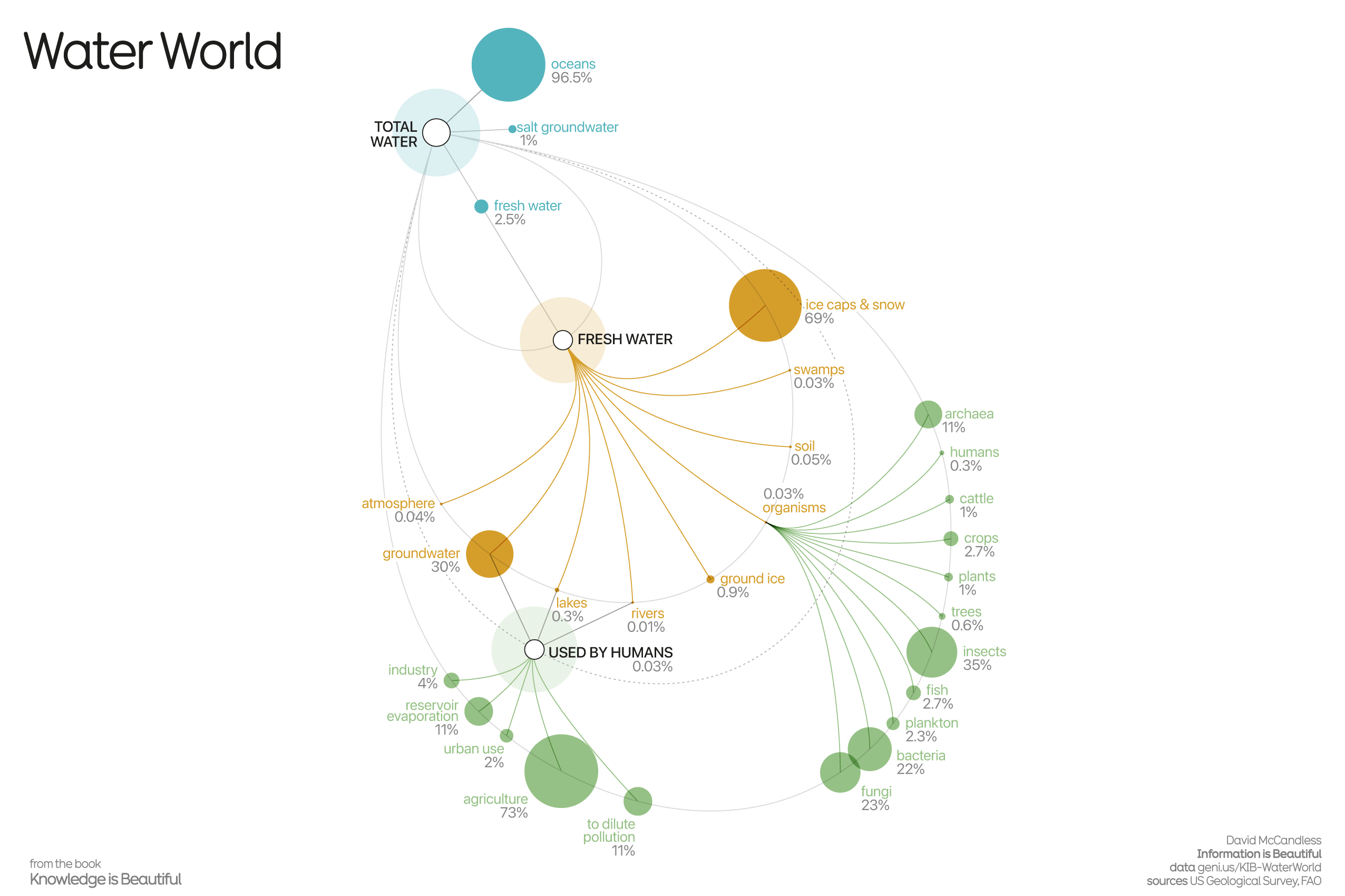
We’ve just started on a Mozilla-funded Friends of the Earth project at the moment around sustainability principles for AI. There seems to be a lot of noise around the amount of water employed to cool the data centres used to train large language models (LLMs).
While we should always be cognisant of the amount of the energy and water used to provide us with new (and existing) technologies, I think there’s a lack of statistical numeracy going on here. For example, in the UK, 51 litres of water per person are lost due to leakage every day. That’s over a trillion litres per year!
Alan Levine shared a link to this visualisation in the thread where I was discussing this stuff on the Fediverse.
Source: Information is Beautiful
Against cyberlibertarianism
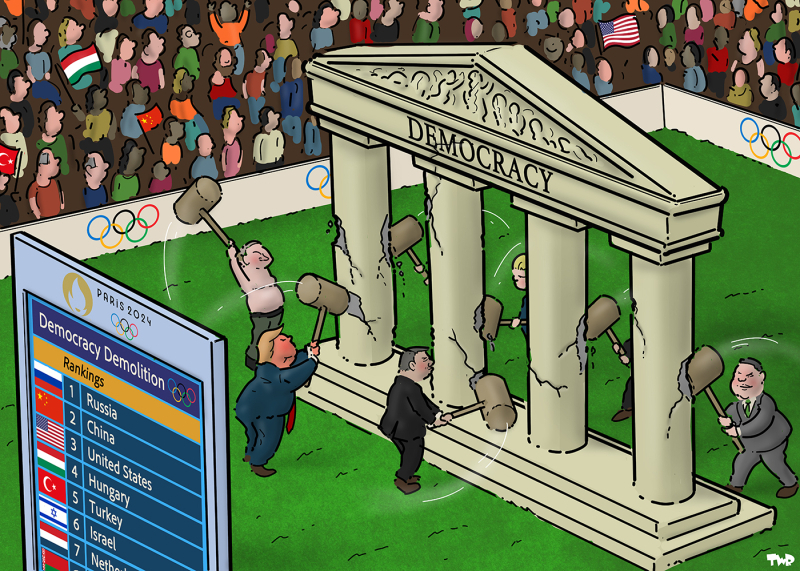
A long-ish and important post by Paris Marx in which he argues for a middle path between the ‘cyberlibertarianism’ of Silicon Valley and the China firewall approach. Just as the laws in most countries have a common based but a different flavour, so I think we’ll see an increasing alignment of what’s allowed online with what’s allowed offline in various jurisdictions.
Instead of solely fighting for digital rights, it’s time to expand that focus to digital sovereignty that considers not just privacy and speech, but the political economy of the internet and the rights of people in different countries to carve out their own visions for their digital futures that don’t align with a cyberlibertarian approach. When we look at the internet today, the primary threat we face comes from massive corporations and the billionaires that control them, and they can only be effectively challenged by wielding the power of government to push back on them. Ultimately, rights are about power, and ceding the power of the state to right-wing, anti-democratic forces is a recipe for disaster, not for the achievement of a libertarian digital utopia. We need to be on guard for when governments overstep, but the kneejerk opposition to internet regulation and disingenuous criticism that comes from some digital rights groups do us no good.
The actions of France and Brazil do have implications for speech, particularly in the case of Twitter/X, but sometimes those restrictions are justified — whether it’s placing stricter rules on what content is allowable on social media platforms, limiting when platforms can knowingly ignore criminal activity, and even banning platforms outright for breaching a country’s local rules. We’re entering a period where internet restrictions can’t just be easily dismissed as abusive actions taken by authoritarian governments, but one where they’re implemented by democratic states with the support of voting publics that are fed up with the reality of what the internet has become. They have no time for cyberlibertarian fantasies.
Counter to the suggestions that come out of the United States, the Chinese model is not the only alternative to Silicon Valley’s continued dominance. There is an opportunity to chart a course that rejects both, along with the pressures for surveillance, profit, and control that drive their growth and expansion. Those geopolitical rivals are a threat to any alternative vision that rejects the existing neo-colonial model of digital technology in favor of one that gives countries authority over the digital domain and the ability for their citizens to consider what tech innovation for the public good could look like. Digital sovereignty will look quite different from the digital world we’ve come to expect, but if the internet has any hope for a future, it’s a path we must fight to be allowed to take.
Source: Disconnect
Image: Tjeerd Royaards
We look through screens rather than at them

I don’t know if you’ve ever been to the place where a famous artist, or musician, or writer was born/worked/died? Although it might be interesting on a surface level, the likelihood is that whoever it was escaped their environment into a world of imagination.
Less tedious to look at are artefacts such as notes, scribbled ideas and marginalia. What happens to all this, though, with a purely digital workflow? What will future historians have to work with? I’m guessing famous writers are similar to me: I don’t write letters to my wife, I sent her messages on Signal; I don’t scribble down ideas on scraps of paper, I make digital notes; I don’t scribble in books; I highlight sections on Kindle or Google Books.
More importantly—for a biographer or anyone trying to tell a good story—the digital version of a hastily scribbled note pinned to the apartment door is less tangible and thus harder to romanticize. Text messages still don’t evoke adventure, even if they are the invisible engine behind most of what happens. They inherently violate the “show don’t tell” rule; they are all telling and no showing. […]
Analog media may not convey information as efficiently, but it has other benefits that may be easier to appreciate in hindsight. It is more decorative. It furnishes the physical environment in a way that digital technology—always evolving toward smaller, smoother, and lighter—does not. Or to put it another way: When digital technology is visible it’s usually because it failed to be invisible. The exception to this is the ever-present screen, which remains visible by definition, obviously; screens now account for nearly all of a computer’s tangible presence in the world. And screens are the exception that prove the rule because, as Byung-Chul Han has noted, we look through them rather than at them. Screens don’t decorate the physical environment so much as they invite us to stare through a window into a different kind of non-place.
Source: Kneeling Bus
More is always more where 'kitchen lipstick' is concerned

I’m a big fan of srirarcha sauce, so this ode by Jay Rayner to ‘lifting’ ordinary dishes with the addition of things you find in cupboards and fridges, spoke to me. My tips? Try coconut in your porridge, and balsamic vinegar (or pesto) on your next pizza.
Where dinner is concerned, God is always in the detail. By this, I mean the kind of dinner you scarf by yourself when it’s so late it’s almost early; the thing you eat when nobody is watching and the options are meagre but you still regard yourself as a person of high gastronomic standards, who sees the lowliest of food items as merely the opening salvo in a negotiation.
Which is how I found myself one night pelting a chicken and mushroom Pot Noodle which just happened to be lurking in the cupboard, with freshly sliced spring onions and batons of ginger, shiny black ribbons of finely chopped toasted nori and dollops of sriracha sauce and crispy chilli oil. And lo: the humble instant noodle has been elevated to the king of snacks, courtesy of my exquisitely honed culinary sensibility, and my endearing conviction that more really is always more.
[…]
A friend of mine describes doing all this as adding “kitchen lipstick”. I get her point: it’s the application of seemingly small details which vastly elevate the otherwise everyday. The original purchase suggests questionable taste. The adornments and embellishments restore one’s sense of self. Perhaps right now you have lurking in the fridge a pot of that grim corner-shop hummus, looking to stunt double as tile grouting? Why not go the full Ottolenghi and decorate it with toasted pine nuts, a thick dusting of smoked paprika, an extra dribble of that grassy olive oil over there and, for a final flourish, finely chopped flat-leaf parsley? Add fancy whole grain mustard and manuka honey to the cheapest of sausages, and glugs of madeira and a spoonful of dijon to instant gravy.
Source: The Guardian
Isolated places in the Lake District for wild camping

I took this photo on Friday night, just after setting up my tent in Eskdale. This is like the land that time forgot on the other side of the Hardknott Pass and somewhere that tourists to the Lake District seldom visit.
Wild camping, while officially illegal in England, is tolerated if you stay out of the way and use some common sense. Before I went, I looked at some other spots, and so wanted to share those with you for your enjoyment.
If you dream of a serene night by a gentle river, look no further than Eskdale. This elongated valley with the River Esk running through it offers perfect wild camping spots with stunning vistas of Scafell and Woolpack Point. During the day, Hardknott Roman Fort and Stanley Ghyll Waterfall are within reach.
Source: IDEAL magazine
Better Images of AI

Have you noticed that most news articles, blog posts, and social media updates that talk about AI use weird robots and unconvincing imagery? This website, which I discovered via Anne Hilliger seeks to address that.
There’s a wide range of Creative Commons-licensed options which I’ll be using to accompany stuff I write about AI — including this post!
Images representing AI as sentient robots mask the accountability of the humans actually developing the technology, and can suggest the presence of robots where there are none.
Such images potentially sow fear, and research shows they can be laden with historical assumptions about gender, ethnicity and religion.
However, finding alternatives can be difficult! That’s why we, a non-profit collaboration, are researching, creating, curating and providing Better Images of AI.
Source: Better Images of AI
AI and community communication
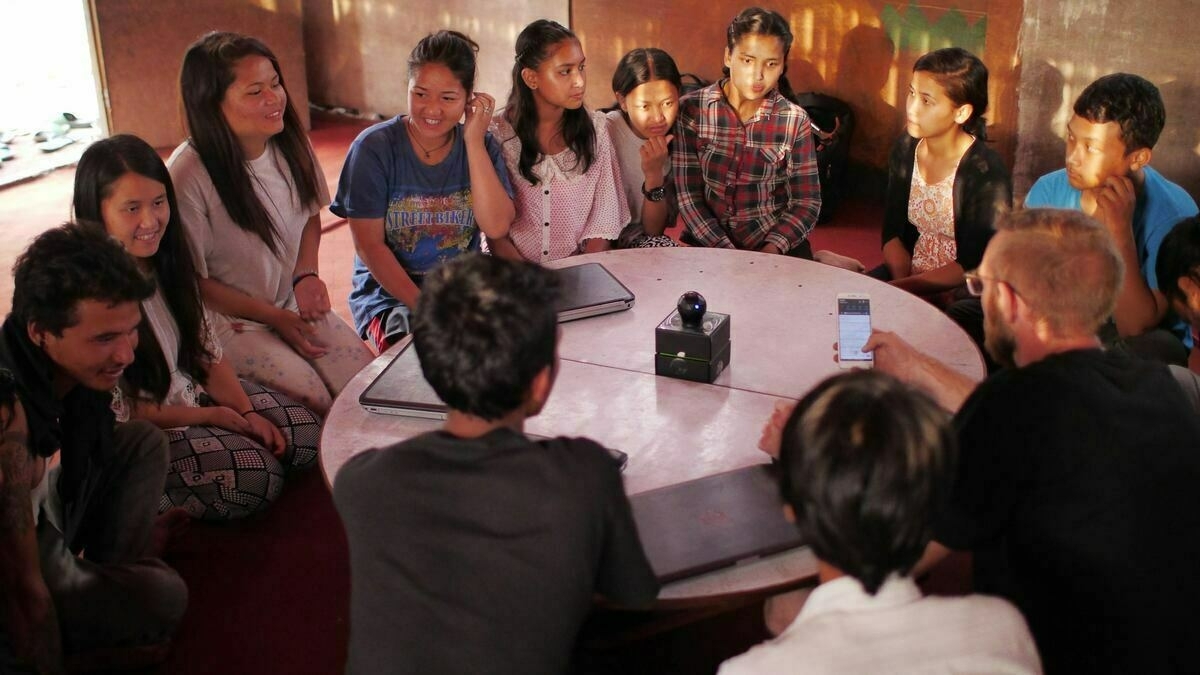
Stephen Downes has written a couple of articles relating Generative AI (GenAI) and Open Education Resources (OER). In the first one, he responds to a blog post by Heather Ross, who argues that the “sould of open is in danger.” Downes is having none of it, and responds to her point by point.
I’m in agreement with all of it, and particularly with how ‘gatekeep-y’ (my word) the OER community can be. (I say this with deep love and respect for what the OER community has achieved, but it is somewhat insular and ivory tower-focused.)
There are a few people who have created a cottage industry for themselves by opposing every aspect of artificial intelligence. I think they’re wrong, and have concerns about them misleading educators about AI. But Heather Ross’s article takes it a step further.
This is colonialism:
“No, you don’t get to wash over or destroy the work we’ve done and the great work still to come within the open movement.” If those encouraging the use of GenAI for open or for GenAI to replace open want to play a new game, that’s fine. We can’t stop you, but get off our field.”
It’s not your field.
And then, in the second post, which contains too many excellent and nuanced thoughts to summarise adequately, Downes sets his sights on what we mean by ‘free learning’. I’m sharing the part about colonialism because I think he gets to the nub of the problem: what people are often complaining about when they’re complaining about AI as ‘colonialist’ is that they are being colonised.
This is, of course, a problem, but the underlying issues are much more structural than people usually think. As Downes points out, what is necessary here isn’t to merely perpetuate the mindset of ‘giving’ people education, but rather to find ways “for a community to communicate with itself” in ways that reduce their reliance on other (usually more powerful) communities and interests.
The only real difference between what we’ll call ‘AI colonialism’ and ‘Good Old Fashioned Colonialism’ is in who is being colonized and who is doing the colonizing. In the case of GOFC, it was one nation colonizing another. In the case of AIC, it is one sector of the economy colonizing the rest. Though if we pause and consider for a bit we’ll find it’s not so different after all: in most societies, developed and otherwise, there is a structural colonialism, where one wealthier sector of society extracts value from the other, and then sells (or in the case of charity, ‘gives’) it back as a value-laden alternative.
I am so sympathetic with those who are opposing AI on these grounds, though my charity is extended only grudgingly to those who have only recently made the switch from colonizer to colonized. And my real loyalties are with those who have always been colonized - not only those in Eswatini (who have to their credit have resisted colonization better than many) but also those in my own society and those like mine, who contribute with their language(s), system of laws, culture and traditions, social knowledge, values and beliefs, etc., and find an educational system - and knowledge economy generally - sold back to them, inevitably changed by the values and beliefs of those who performed the appropriation.
This is an unsustainable model. Over time, it not only reduces the wealth of the subjected population, it also reduces the capacity of the provider (or ‘donor’) community generate wealth without these inputs (one imagines that a company like Disney would flounder without the privilege to incorporate and repurpose Arab or Indigenous culture and folklore).
[…]
Whether or not AI succeeds as a technology is moot; neither blocking AI nor regulating the industry will alter the model of aggregation and exploitation that it exemplifies. The knowledge, learning and information industries will continue to exist, and with or without AI will continue to harvest community language(s), system of laws, culture and traditions, social knowledge, values and beliefs, etc., and in some fashion reshape them according to their own values and sell them back to the community.
And this brings us back to what, to my mind, is the real purpose of open educational resources. They represent a means, mostly (though not exclusively) through digital technology, for a community to communicate with itself, to gather and share knowledge, to pass along its values and mores, its ideas and beliefs, and to be able to do this without reliance on external knowledge, information and learning providers.
[…]
It - to me, at least - was never about giving people an education (or giving them rights, or freedoms or anything else). It was about people being able to create these things for itself.
Sources:
- What is the Soul of Open Educational Resources?
- Why Free Learning Needs Free Artificial Intelligence
Image: tribesh kayastha
Migration → Adaptation → Carbon removal → Geoengineering

I’ve already shared “technologist and climate geek” Ben James' most recent blog post about off-grid solar power. Digging into other posts unearthed one about his opinion that either “a country with no choice” or a billionaire will unilaterally start spraying sulphur into the stratosphere to help cool the earth. Or at least stop it heating so quickly.
Solar Radiation Management (SRM), as it’s known, is controversial, but has become less so recently. There’s an argument to be made that the $20 billion cost per year would be well worth it to buy us more time. I don’t know enough about this, but it’s clear that this is something that is likely to be on the table as a strategy, and probably won’t go through the UN or an international body first.
Sulfur disappears from the atmosphere quickly - it rains out after about a year. This means that once we’ve started SRM, it’s dangerous to suddenly stop. We need to keep spraying particles, all the time. If we suddenly stopped, the warming would spring back rapidly, causing a bad temperature shock. The correct way to stop is a gradual phase out.
Unfortunately, Solar Radiation Management (SRM) has some fairly gigantic problems.
It doesn’t fix the root cause. Cooling the planet does not remove the CO2 which has accumulated in our atmosphere. It doesn’t stop that CO2 from acidifying the oceans and irreversibly destroying marine biodiversity.
SRM could make us complacent about dramatically cutting emissions.
Sulfur increases acid rain (harmful to many life forms) and will likely harm the ozone.
If SRM is poorly implemented, it could dramatically change weather and rainfall patterns. For example, if sulfur is not injected near the equator, it will not evenly mix into the stratosphere, causing uneven cooling and heating.
[…]
Crucially, the biggest problems with SRM are probably not yet known. The side effects of putting sulfur into the stratosphere could be some of the most consequential unknowns in human history. Clearly, that’s a huge reason to do more research. But still - no matter how much research is done, when humanity tries to bend nature to its will, we can be sure that unintended consequences won’t be far behind.
[…]
People underestimate how controversial it can become to not do SRM. Imagine you are the leader of a country close to the equator. Crop failures, extreme heat, and city-destroying cyclones mean that your people are without drinkable water, have nowhere to sleep, and cannot feed their children. Mass social unrest and physical violence become normal for your country. SRM is the only action that you can take to turn off the disasters, and prevent your government being overthrown.
[..]
Ultimately, the decision to turn on the SRM machines will not be made by climate scientists, or carefully calculated risks. It will be made on the basis of nations rising or falling - by starving populations, revolutionaries, and leaders with their back against a wall.
[…]
Geoengineering is no replacement for getting our shit together. But there would be no honour in allowing the deaths of hundreds of millions of people, simply because they could have theoretically been avoided through more mitigation.
[…]
SRM might not make sense in your mind (it certainly doesn’t in mine). But do you view the world in the same way as a military dictator, “benevolent” billionaire, or leader of a starving country?
Source: Ben James
Some men just want to watch the world burn (and now there's research to prove it)

There’s a scene in one of my favourite films, The Dark Knight in which Arthur, Bruce Wayne’s butler, explains that “some men just want to watch the world burn.” There are some mighty fine memes as a result.
But it’s true. Sometimes it’s because they’ve got no power, so they might as well provoke something that might be entertaining. What have they got to lose. Other times, it’s because they’ve got all the power, and they have crazy theories about world overpopulation.
Either way, there’s new research into this mindset which shows that this is a psychological trait separate to others. I’m going to quote Brian Klaas at length, who explains in an excellent post.
These people, according to the new research, share a desire to “unleash chaos to ‘burn down’ the entire political order in the hope they gain status in the process.” This trait now has a name — and an established psychological profile.
It’s called the “Need for Chaos.” Understanding it provides an important insight into the destructive world of modern politics, in which the trolls have taken over, and politicians are no longer problem solvers, but are rather political influencers. It’s not about making the world better. It’s about burning down the world of people they hate.
[…]
In particular, people who score high on this metric tend to answer that they agree with several of these statements:
I get a kick when natural disasters strike in foreign countries.
I fantasize about a natural disaster wiping out most of humanity such that a small group of people can start all over.
I think society should be burned to the ground.
When I think about our political and social institutions, I cannot help thinking “just let them all burn.”
We cannot fix the problems in our social institutions, we need to tear them down and start over.
I need chaos around me—it is too boring if nothing is going on.
Sometimes I just feel like destroying beautiful things.
Then, to make sure that people weren’t just ticking the box next to every question mindlessly, the researchers included two additional statements that were the opposite of the other seven:
We need to uphold order by doing what is right, not what is wrong.
It’s better to live in a society where there is order and clear rules than one where anything goes.
Interestingly, when they looked at other toxic personality profiles — such as psychopathy (being a psychopath) and social dominance orientation (an urge to assert social dominance) — they found that the Need for Chaos was a separate dimension to destructive individuals. It wasn’t just capturing the same impulse.
It’s a unique trait.
[…]
The Need for Chaos trait is particularly damaging for individuals who also feel that they’ve been failed by society, manifesting in their loneliness. For them, sowing chaos is a way to lash out against the system while asserting their power and trying to establish some form of social status.
[…]
That creates a strange dynamic, in which most white men—by virtue of their historically privileged position in society—tend to score lower on Need for Chaos than other groups. However, when white men do score high on Need for Chaos, it’s particularly dangerous. To put it plainly, the research suggests that of those who have this chaotic trait, it’s most destructive when that person is a white man.
[…]
The challenge for modern politics, then, lies with figuring out a way to deal with the inevitable perceived loss of social status that accompanies a society that’s becoming more equal, while mitigating the damage that these aggrieved chaos agents can inflict on everyone else.
Source: The Garden of Forking Paths
A State of Systems Shifting
A decade ago, I was going to so many in-person conferences that I had both a dedicated blog and Twitter account. These days, I attend rather less. No longer being on Twitter, and my conference blog long-ago being mothballed, I’m lacking a place to put reflections on events.
The purpose of this post isn’t even that, to be honest. I was just so blown away by Indy Johar’s presentation at the Systems Innovation Network conference today that I needed somewhere less ephemeral to put the notes that I managed to tap out with my thumb.
Don’t ask me questions about any of this. Not only am I still new to the whole world of systems thinking, but Indy seems to have a galaxy-level brain. Go and check out the Dark Matter Labs website.
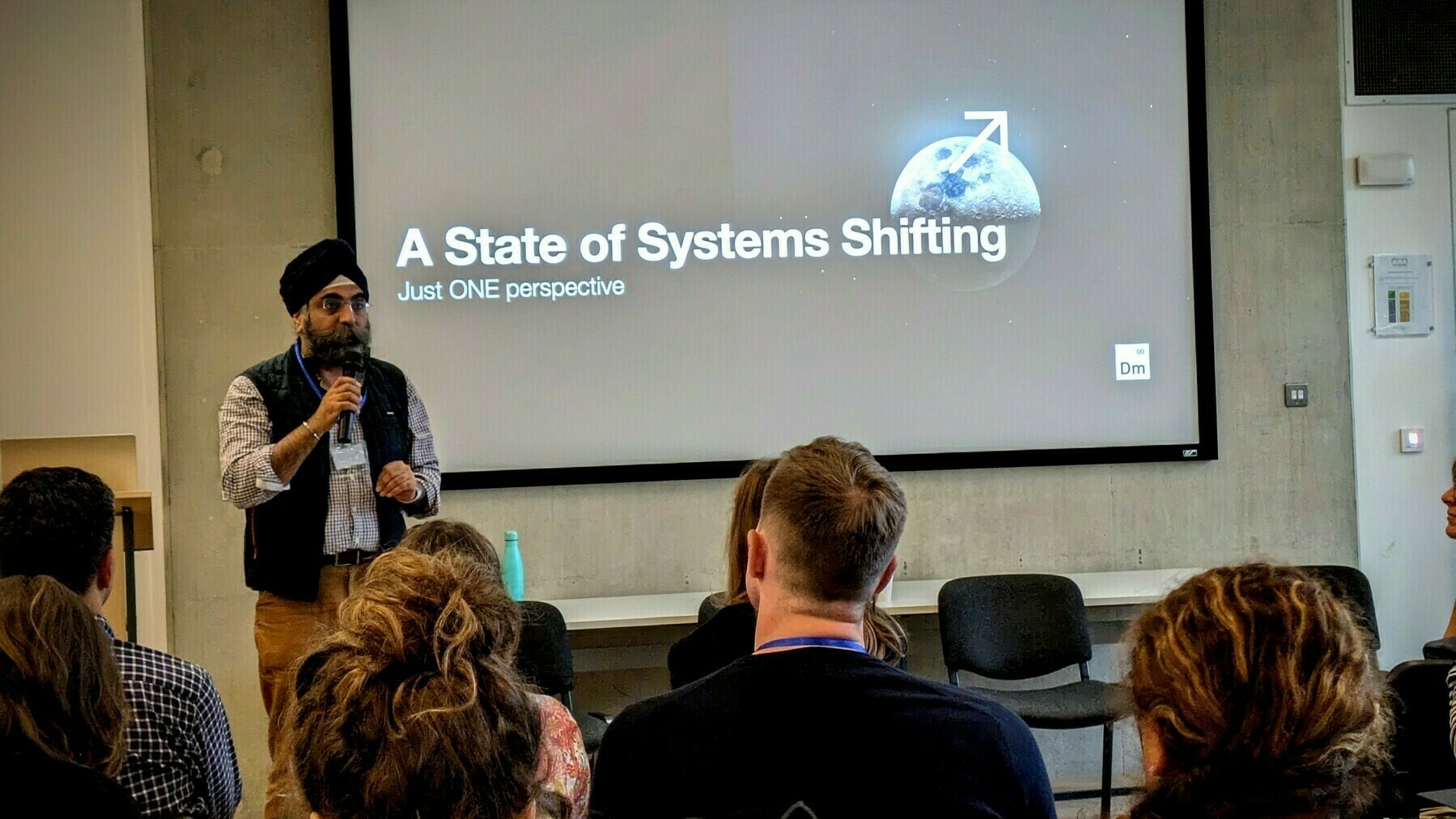
Situating the moment:
-
Climate breakdown (not change, losing predictability and insurability - therefore access to capital markets)
-
Mass multi-polar, multi-perspectival transition (different kinds of transitions in different parts of the world)
-
Securitization of everything (pervasive in all of our conversations - everything driven by risk and security - energy, minerals, nutrient supplies)
Emergent term of ‘security economics’ changing market dynamics. ‘No transition without justice’ not simply a slogan, it’s important to be able to find a way forward (e.g. UBI or ‘universal basic nutrition’ experiments)
-
Inequality and loss of solidarity
-
Hugh interest rate environment - inflationary economic context. Going to see more shocks to the economic system.
Difficult to price the material economy because of volatility.
- Rise of environmental righy politics - localism, etc. will be co-opted by the far right. AfD / far-right of Conservative Party. Boundary words: who’s inside and outside the community.
Systems Practitioners shouldn’t use ‘community’ as too entangled. Be careful about language we’re giving power to.
- Labouring the transition - don’t have a labour force for the transition (great ideas, but can’t implement them).
Having to think about the constraints in the innovation landscape. Materially affecting our reality: UK can afford to build 14,000/year according to Paris Agreement carbon budget. Labour government has promised to build 350,000/year. Need to do things differently - open up new pathways (right to homes).
Persisting with illusions of infinite supply - instead we need to look at constraints because that’s where the innovation is.
- Flooding with information - c.f. McLuhan’s thought about confusing a system by flooding it with info. People just spot patterns.
Far right give you a meme to help you understand reality - they hijack a pattern analysis.
-
Scale of the shift - only 7.2% of global economy is ‘circular’ and it’s declining. Need fundamental shifts in material economy.
-
Volatility in the system massively increasing - energy costs, food costs
-
New Allies - central banks, security services, intergenerational wealth, civil society. Need to have representatives from these types of organisations at this conference. New theories about asset ownership.
Westminster living in synthetic domain. Everyday politics to what we’re observing.
“Systems is about conversation not communication.” This means we can deal with more information than previously thought.
Security & Resilience of Systems
“Pre-emptive peace strikes” in places where there’s risk of systemic volatility.
Risk to whom? Rooted in assets and value, rooted in monetary frameworks. Preservation of power.
Uncrystalised risk in the system. If you put the risks on the balance sheets, the organisations aren’t solvent anymore. No longer viable. Collision and corruption therefore becomes a systemic risk - interested in survival.
(e.g. of Kristallnacht and insurance companies not paying for broken windows but instead paying ‘force majeure’ money to Nazi Party)
Explosion of sovereignties - more of an agentified world view. People don’t ‘assign’ their sovereignty to the state as they did in the past. Multitude of sovereignties.
Need to work beyond democratic renewal systems - legitimacy? “States are not the public”
Systems scaffolding - who owns the solution for portfolio (unless the system wants to implement, just remain as sticky notes). Need to work as system capabilities level.
Trans-systems work. Structural systems transformation.
Constraints - key shifter of innovation space.
‘Trap’ of the system boundary and the other. Need to build new language. Different dynamics to bounded models.
Systemic gap in price and value. Unpriced value in the system - going to be something that organised a lot of systems work (e.g. looking at single food product or wider systems level)
Deep Code failure at systems level. Language probel - use old world language which traps us. Also ‘property rights’ like to be challenged.
[Dark Matter iceberg graphic]
Building compound learning organisations and systems. Freedom and agency must lie in the actor for a system to be a system. That means learning. How do we build these?
Chief Learning Officers instead of CEOs. Coherence is formed not around risk but about capacity to learn. Higher overheads, but higher resilience and innovation capacities.
Crisis-driven system transitions. We’re going to live in a world where crises shatter Overton Windows. Emerging Theory of Change.
Big challenge is legitimacy. Mountains over mountains.
Single-point optimisation doesn’t work for an entangled planet. Need to focus on multi-point optimisation.
Multi-organisation organising. Contracting and coordination makes that difficult - what are the frameworks here?
Difficult for states to impose transition, needs to be negotiated.
System financing, structured economic systems, and para-colonizing financial capital. How do you move capital through a non-colonial lens? Capital is an extension of the dominion theory of the world.
‘System accelerators’
Intermediary agent-trust economy. How to build a different way to finance things. Turning energy meter into financial instrument? Public interest micro-trusts. Way of regulating the translation space. Weak signal.
Relationship with material economy - borrowing, not owning.
Freedom and systems - we need to build capacity for agents to be free (not in terms of market choice, but free in terms of being radically human). People and institutions feel trapped. Combined with volatility and uncertainty this creates fear.
First movers - food, material economy
We’re trying to make stuff circular that shouldn’t be. Biomaterial level? Needs to interact with nutrition system. Also river systems work (key fragility point)
Dark Matter Labs has new publication about portfolios - who owns them? New ways of organising to deal with portfolio allocation.
Problem of having the incumbents in the room when we’re talking about system transitions. 40% of the people who this issue will affect aren’t even born. Might be worth having empty seats to recognise this?
We don’t have data infrastructure - cities can’t calculate carbon emissions. Can’t just be ‘open data’ as requires security.
Operating in a deep war of values - e.g. billionaires willing to throw money at throttling the human race because they think this is the answer. Accelerating towards a ‘throttling event’. Very different perspectives on the table.
Our own governance - need integrity. Systemic question.
Financing the deep work - real issue, end up talking about surface level.
How do we move from communities of care based on fear (i.e. the far right) to communities of care based on love?